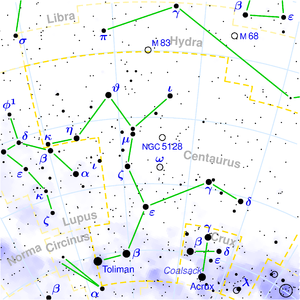 A large, striking and object-rich constellation in the southern sky, the northern parts of which are still visible from central Europe in the spring months. The constellation's two brightest stars - α Centauri, also called Toliman or Rigil Centaurus - and β Centauri - Agena or Hadar - form the centaur's legs and are also a landmark for locating the South Celestial Pole and the Crux. The latter was still part of the Centaurus in Ptolemy's time, only later becoming a separate constellation. Unfortunately, these regions are now too far south and cannot be seen from Europe. A rich Milky Way region passes through the southern part of the constellation and therefore, especially in its central and eastern part towards the borders of Lupus, we can observe several nice open clusters. By far the most famous object, however, is the impressive globular cluster Omega Centauri, the brightest in the entire sky. Also worth noting is the large and bright galaxy NGC 5128 in the center with its dark band, one of the strongest radio sources in the sky.
A large, striking and object-rich constellation in the southern sky, the northern parts of which are still visible from central Europe in the spring months. The constellation's two brightest stars - α Centauri, also called Toliman or Rigil Centaurus - and β Centauri - Agena or Hadar - form the centaur's legs and are also a landmark for locating the South Celestial Pole and the Crux. The latter was still part of the Centaurus in Ptolemy's time, only later becoming a separate constellation. Unfortunately, these regions are now too far south and cannot be seen from Europe. A rich Milky Way region passes through the southern part of the constellation and therefore, especially in its central and eastern part towards the borders of Lupus, we can observe several nice open clusters. By far the most famous object, however, is the impressive globular cluster Omega Centauri, the brightest in the entire sky. Also worth noting is the large and bright galaxy NGC 5128 in the center with its dark band, one of the strongest radio sources in the sky.
South of λ Centauri lies a dark nebula, called the False Coal Cack by southern observers, at the boundary between Centaurus, the Centaurus and the Musca. While not as conspicuous by comparison because of a few foreground stars, it is considerably larger. Its contrast to its surroundings is not quite as stark, yet it is clearly visible compared to the Milky Way. The beautiful cluster Melotte 115, which consists of many faint stars, also appears in the binocular near it. Near Alpha Centauri, a complex of dark clouds called the Trench begins, dividing the Milky Way in two. It gradually grows in width and continues to the centre of the Galaxy, because the beginning of the galaxy at Alpha Centauri is further away than the other end, so it is also narrower and more sharply defined at this point.
Toliman (α Centauri) - It is the brightest star in the constellation and the third brightest star in the sky after Sirius and Canopus. However, it is located quite far south and can only be seen just above the horizon during culmination from 25 degrees north latitude. At a distance of 4.36 light-years, it is our closest star visible to the naked eye. In reality, it consists of two yellow components with magnitudes of 0.1 and 1.3, which can usually be easily distinguished even with a small telescope - at the turn of the millennium, their separation reached 14.1". In 2035, this distance will only decrease to 2 arc seconds. Their mutual orbital period around the common center of mass is 80 years. The α Centauri system is actually our closest stellar system. However, our closest star is actually a red dwarf with a magnitude of 10.7 called Proxima Centauri, which is also physically related to this system.
Hadar (β Centauri) - or also known as Agena. With its magnitude of 0.9, it is the 10th brightest star in the sky. Together with the star Toliman, which is only four and a half degrees away, it forms a good reference point for identifying the Southern Cross and prevents its confusion with the so-called False Cross, which is formed by the stars of the Keel and the Sail. Although this blue-white supergiant is fainter in the sky compared to Toliman, it is located about 100 times further away. Its absolute magnitude reaches -5.5. If it were located in the place of Toliman, it would have an apparent magnitude of about -10!
3 Cen - A remarkable pair of unequally bright pale blue stars with magnitudes of 4.5 and 6, which are separated by 7.9".
4 Cen - An attractive double star composed of a pale blue 4.7 magnitude component and a gray-white component with a magnitude of 8.4, which is located at a distance of 14.9".
R Cen - The variable star of Mira type is located between the stars α and β Centauri. Its brightness varies from 5.3mag to 11.8mag over a period of 546 days.
Herschel 4423 - An attractive pair of yellow stars dominates a relatively sparse field of stars. The components have apparent magnitudes of 6.9 and 7.2, and they are separated by 2.4 arcseconds.
Proxima Centauri - 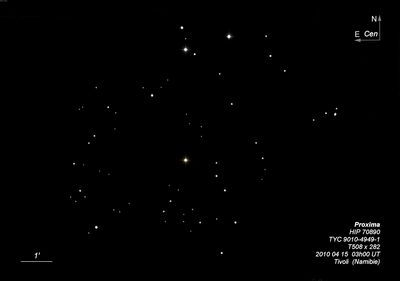
In 1915, R. T. Innes measured the proper motions of stars around α Centauri. At a distance of 2.2 arc degrees southwest of this star, he found a star with a brightness of 10.7 mag, which was moving in the same direction and at the same speed as both components of α Centauri. This red dwarf is actually our closest star to the Sun, only 4.25 light-years away. It is likely part of the α Centauri system, although it orbits at a very large distance. In a few thousand years, when it passes Toliman, it will no longer be our closest star. Proxima, which means "closest" in Latin, occasionally brightens by more than half a magnitude and usually returns to its original brightness within half an hour. Proxima Centauri is a small star, with a mass only 1/10 of the Sun's mass, and it is very faint, shining less than 0.0008 times the brightness of the Sun.
NGC 5139
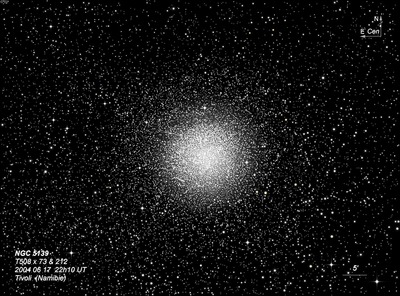
10x30mm Canon IS (3/28/19 - Tasmania): very prominent naked-eye as Omega Centauri culminated within 5° of the zenith from this southern location. Huge in 10x30mm, though no resolution.
Ptolemy catalogued Omega Centauri = NGC 5139 = Lac I-5 = D 440 = h3504 as a star in the Almagest (150 AD). Edmond Halley discovered its nebulous nature telescopically in 1676-77 from the island of St. Helena. He included it in a short list of a half-dozen "luminous spots or patches" found while cataloguing southern stars. Nicolas-Louis de Lacaille reported "Naked eye, a 3rd mag star [10 Cen] in a fog. Telescope, [Half-an-inch aperture, 8x magnification] like a big diffuse comet." James Dunlop first resolved the cluster on 7 May 1826 with his 9-inch speculum reflector and described "a beautiful large bright round nebula, about 10' or 12' diameter, easily resolvable to the very centre; it is a beautiful globe of stars very gradually and moderately compressed to the centre; the stars are rather scattered preceding and following, and the greatest condensation is rather north of the centre: the stars are of slightly mixed mags, of a white colour. This is the largest bright nebula in the southern hemisphere." Of course, the cluster is an easy naked-eye object. Johann Bayer catalogued it as a 4th magnitude star (Omega) in the early 17th century.
John Herschel first observed Omega Centauri on 26 Feb 1834, a few days after setting up his 20-foot telescope in South Africa. He wrote in his diary, "a most superb object - entirely resolved into stars of 13...14m. All very nearly of the same size & most beautfilly graduating in respect of central condensation."
In a detailed observation on 20 Apr 1836, he recorded "Globular; Omega Centauri; diameter full 20'. It much more than fills the field. When the centre is on the edge of the field, the outer stars extend fully half a radius beyond the middle of it. The stars are singularly equal, and distributed with the most exact equality, the condensation being that of a sphere equally filled. - Looking attentively, I retract what is said about the equal scattering and equal sizes of the stars. There are two sizes 12th mag and 13th mag, without greater or less, and the larger stars form rings like lace-work on it. One of these rings, 1.5' in diameter, is so marked as to give the appearance of a comparative darkness like a hole in the centre. There must be thousands of stars. To the naked eye it appears as a star of 5th mag or 5.4, rather hazy. There is a * 9m on the S.p. border of it, about 4' or 5' south of centre, and several 8th mag are scattered far away. My attendant (John Stone) called up, who saw the hole and darkness, and described it as I have done above. On further attention the hole is double, or an oval space crossed by a bridge of stars. Position of axis = 150°. Altogether this object is truly astonishing." The position in John Herschel's General Catalogue, as well as the NGC, is 10' too far north.
200/250mm - 8" (7/13/91 - Southern Baja): very bright, very large, very broadly concentrated, about 25' diameter, over 100 stars resolved mag 12-13, many in curving streams over the entire disc. Visible naked-eye.
300/350mm - 12" (6/29/02 - Bargo, Australia): this was the first object I viewed at Bargo with Les Dalrymple's 12" and I was not disappointed. At 140x, it filled 2/3 of the field (over 25') and resolved into perhaps a few thousand stars down to the center. The cluster seemed almost 3-dimensional with a lattice of brighter mag 12 stars superimposed on a dense background layer of mag 13-14 stars. The density was generally uniformly high in the elongated halo except near the edge although the core shows more non-uniformity with a couple of darker patches.
400/500mm - 17.5" (3/12/88): very large, very bright, fantastic at 220x with several hundred stars resolved in excellent seeing from east of Mt. Hamilton. Very faintly visible to the naked eye in good conditions near the horizon from northern California.
600/800mm - 24" (4/11/08 - Magellan Observatory, Australia): at 200x in excellent seeing, the view was absolutely stunning as the field was packed with thousands of pinpoint stars to the edge of the 30' field! I noted the circular ring of stars near the center mentioned previously, but the large number of brighter, densely packed stars in the core and halo, superimposed on an incredibly rich mat of fainter stars was the real show. The cluster is only broadly concentrated with very large, brighter core ~10' in diameter and the star density thins out very slowly all the way to 35' diameter.
Notes by Steve Gottlieb
NGC 5128
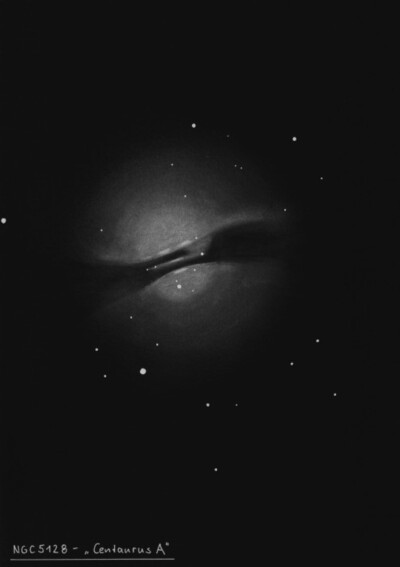
James Dunlop discovered NGC 5128 = D 482 = Centaurus A = h3501 on 29 Apr 1826 using his 9-inch f/12 homemade speculum reflector from Parramatta (near Sydney). It was discovered on the second night he started recording deep sky objects -- NGC 4945 was discovered just 20 minutes earlier! He reported "A very singular double nebula, about 2.5' long and 1' broad, a little unequal: there is a pretty bright small star in the south extremity of the southernmost of the two, resembling a bright nucleus: the northern and rather smaller nebula is faint in the middle, and has the appearance of a condensation of the nebulous matter near each extremity. These two nebulae are completely distinct from each other, and no connection of the nebulous matters between them. There is a very minute star in the dark space between the preceding extremities of the nebula; they are extended in the parallel of the equator nearly." His sketch (Figure 20) shows two parallel bands with a star between at one end.
John Herschel made several observations: on 1 Jun 1834 he logged "A most wonderful object; a nebula vB; vL; lE; vgmbM; of an elliptic figure, cut away in the middle by a perfectly definite straight cut 40" broad; pos = 120.3 ; dimensions of the nebula 5' by 4'. The internal edges have a gleaming light like the moonlight touching the outline in a transparency." On his next sweep he describing "[Two nebulae, or two portions of one separated by a division or cut.] The cut is broad and sharp. The two nebulae are very nearly alike. Perhaps the slit is larger towards the N.p. end, where there is a star between them. There is certainly a very feeble trace of nebula, an island as it were, running from this star between the sides of the slit." He included a small sketch in a letter written a few days later to his Aunt Caroline (see plate IV, figure 2).
Pietro Baracchi made a detailed observation on 9 Apr 1885 with the Great Melbourne Telescope. He wrote in part "...two very elongated streaks running near one another with their inner edges parallel leaving a channel between them quite dark, about 9' long 50" broad. A very very narrow streak like or string seems to emanate rom a star with the channel towards it n.p. end and run along its axis for about 3'. This narrow streak is very faint. The channel seems to open into a slightly wider spine bounded by much fainter nebulosity into a form a little elongated, irregularly approaching an elliptical shape. But this n.p. end of the channel is not quite closed. It leaves a perfect dark opening in the open n.p. of the object..."
In 1918 Heber Curtis mentioned Cen A as "almost certainly belong to the class of edgewise spirals with dark lane" based on descriptions or sketches, though in 1933 simply classified it as "diffuse. Edwin Hubble, in his 1922 paper "A general study of diffuse galactic nebulae", thought it might be an emission nebula and included it in a table of "Diffuse Nebulae with Emission Spectra", along with M42, the Veil, M8, M16, M17, etc. The Helwan Observatory description from 1921, based on a 30-inch photo from Knox-Shaw, also states "large patch of structureless and possibly gaseous nebulosity.", though no spectrum was taken. The Shapley-Ames catalogue (1932) classified it as an external nebula and in 1947 Harlow Shapley called it as an irregular galaxy.
300/350mm - 13" (4/24/82): wide dust lane bisects galaxy with the southwest hemisphere dominating in terms of size and brightness. A very faint star is at the southwest edge of the dust lane.
400/500mm - 17.5" (3/12/88): bright, large, very large prominent dust lane oriented NW-SE. The SW hemisphere is larger and brighter. A star is superimposed at the south edge of the dust lane (west of center) and a bright star is superimposed on the SW hemisphere (south of center).
600/800mm - 24" (4/11/08 - Magellan Observatory, Australia): I didn't take detailed notes with the 24", but the appearance was mesmerizing at 200x. The equatorial dust lane was more full of contrast and exhibited finer texture and scalloped detail at the edges than I've observed previously in smaller scopes from Australia.
900/1200mm - 48" (4/13/10): at 330x there was a fascinating amount of structure in the wide, equatorial dark lane that bisects the galaxy. The dust lane varied in width with fine structure resolved along its ragged, crenated edge. The interior of the dust lane also varied in brightness with a bright patch close to the center, just following a bright mag 12 star near the south edge of the lane. This patch is elongated with some structure and may be the visible portion of the obscured core. Clouds interrupted this brief observation.
48" (5/9/18): at 610x and 813x; using a DSS2 (Red) finder chart, I easily star hopped over to the globular cluster [VHH81] 7, the first one discovered in NGC 5128 in 1980, starting at the double star HJ 4587 = 9.4/9.5 at 5". I didn't see the see the GC initially at 610x, but bumping the power up to 813x it was identified with certainty about 30" SE of three brighter mag 15-16 stars. The globular (V = 17.2) seemed stellar and was glimpsed for brief moments several times at the same position.
Notes by Steve Gottlieb
NGC 3766
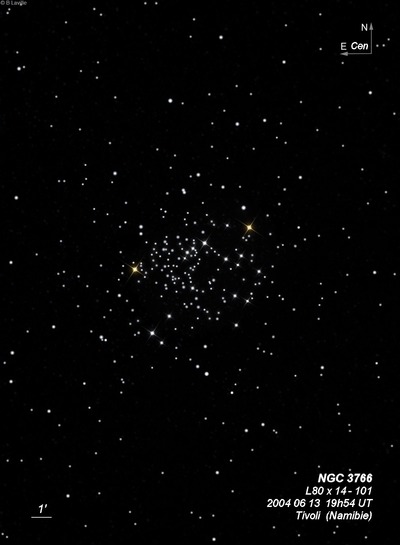
10x30mm Canon IS (3/28/19 - Tasmania): easy naked-eye cluster in a gorgeous wide-angle binocular field! Situated within a superb string of bright stars. Very bright, high surface brightness cluster with a few resolved stars, moderately large and well defined. A few additional stars popped on and off.
Nicolas-Louis de Lacaille discovered NGC 3766 = Lac III-7 = D 289 = h3352 in 1751-1752 with a 1/2-inch telescope at 8x during his expedition to the Cape of Good Hope. He noted "three faint stars in nebulosity". James Dunlop observed the cluster on 27 Apr 1826 (first night logging objects) and noted, "A pretty large cluster of stars of mixt magnitudes, about 10' diameter. The greater number of the stars are of a pale white colour. There is a red star near the preceding side; another of the same size and colour near the following side; another small red star near the centre; and a yellow star near the south following extremity, all in the cluster." Dunlop's position was about 10' too far SE.
John Herschel first observed the cluster on 14 Mar 1834 and noted "the preceding of two chief stars of a fine, large, loose, round cluster of stars 8..12th mag; gradually pretty much brighter in the middle, fills field; 150..200 stars." Two sweeps later he recorded, "A very fine cluster class VII; nearly round, 8' diameter, slightly compressed in the middle, stars of 9..15th magnitude; place that of an orange star 9..10th mag following the centre."
300/350mm - 13.1" (2/18/04 - Costa Rica): this is a superb naked-eye open cluster in Centaurus with several hundred stars resolved in a 15' field. It contains a very dense mass of stars in the central 5' that are seemingly arranged in a spiral configuration as well as a beautiful string of stars running SW-NE on the south side of the cluster. A mag 7.2 M-type reddish star (SAO 251470) lies at the NW end, a mag 7.5 star is on the east side (HD 306799) and a mag 7.1 star (HD 100943) is on the SE side. On the N end is B798, a mag 9.1/9.4 pair at 5" separation. This impressive cluster was a surprising showpiece as it wasn't on my radar as an excellent cluster. Located 50' NW of a mag 5.1 star and 1.4° due north of mag 3.1 Lambda Centauri.
Notes by Steve Gottlieb
NGC 5460
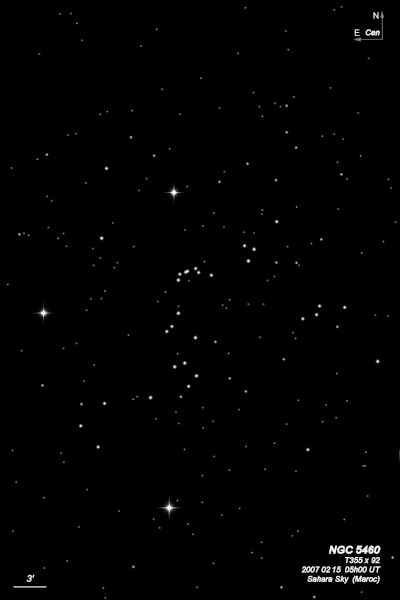
James Dunlop discovered NGC 5460 = D 431= h3555 on 7 May 1826 from Parramatta with his 9.75-inch speculum reflector and described "a curiously curved line of small stars of nearly equal magnitudes; two stars of 7th magnitude following." He observed the cluster 3 times. John Herschel first observed the cluster on 6 Aug 1831 and recorded "a region of large, bright stars, 8, 9...etc. mag; a very coarse cluster. Place that of a brilliant group, one of which is a double star class III." Two nights later he wrote, "Place of a double star in a semi-elliptic group forming part of it, but insulated in a large scattered cluster or tract of bright stars." On a later sweep he logged "a region of large stars very loosely distributed, but which yet decidedly form a cluster. Place that of a pretty close double star (four arcseconds) in the middle of a group of 8. The cluster is 30' diameter, and is divided into distinct groups."
300/350mm - 13.1" (3/17/86): about three dozen stars, bright, large, includes several double stars. Appears scattered with stars arranged in distinct groups with a tight chain in center. Located 23' N of mag 6.4 HD 123247. This is one of the southernmost clusters visible from Northern California sites, but was still very pretty.
400/500mm - 22" (6/28/06 - Hawaii): this bright, very large cluster of ~120 stars extends to 30' diameter at 110x. Many of the brighter stars are arranged in a very distinctive winding curve (fractured into groups) that snakes from NW to SE. At the center is a looping chain of eight mag 7 to 10 stars including a nice double h4647 = 9.3/9.6 at 11". At the NW and south ends are hooks of stars like the tail end of Scorpius. ESO 221-25, a faint galaxy, is hidden among the brighter stars and was not noticed.
Notes by Steve Gottlieb
IC 2948
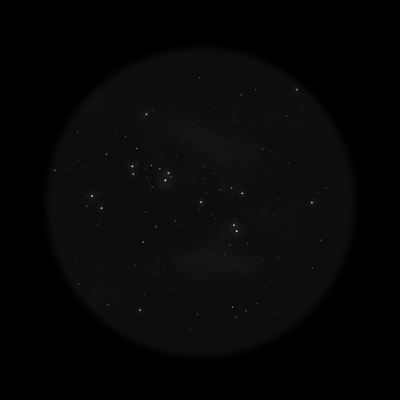
Cr 249 = Lambda Cen cluster is a bright group of two dozen stars elongated NW-SE, ~12'-15' diameter, centered ~30' SE of 3rd magnitude Lambda Cen. Situated in the midst of a fascinating field of nebulosity and dark lane which run just north of the cluster and which spreads out to the east of the cluster! The field seems riddled with dark lanes and brighter patches. Mag 6.5 HD 101205 is near the center of the group and a mag 7 star lies 4.6' NW.
10x30mm Canon IS (3/28/19 - Tasmania): prominent region in 10x30 binoculars. Includes Lambda Centauri and 4 bright stars in a string to the southeast. These stars are involved in an extremely large nebulous haze (unfiltered).
Royal H. Frost discovered IC 2948 = F. 790, along with IC 2944, on a photographic plate taken 5 May 1904 with the 24-inch refractor at the Arequipa station. He noted nebulosity only. See notes on IC 2944.
H.E.W. described the region in 1910 at the Union Observatory in Johannesburg, probably based on a photograph taken with the Franlin-Adams camera. "A very large nebulous region - irregular n shape, somewhat resembling a pear. The star Lambda Centauri is involved in the nebula at the narrow end of the of the pear. The stars CPD -62°, 2154, 2168, 2164, 2186, 2184, 2206and 2142 are also surrounded by nebulosity. There are rigts through the nebula breaing it up into three main portions. The bright portion of the nebula covers about 40' in declination and 5 minutes in RA, but there are fainter extensions about 1° from the main body."
300/350mm - 13.1" (2/18/04 - Costa Rica): this is a bright and fascinating HII region southeast of Lambda Centauri using an OIII filter and a 20mm Nagler combination! Surrounds open cluster Cr 249 (notes below), which is encased in nebulosity. Additional haze extends beyond the cluster towards the southeast for several arcminutes. At this point there is a sharp bend and a bright section of nebulosity extends to the north. This section is wider and brighter than other regions. The brightest sections roughly form a huge "7" shape, perhaps 30' in size! This object is referred to as the "Running Chicken Nebula" and photographs reveal several embedded Bok globules.
Notes by Steve Gottlieb
NGC 3918
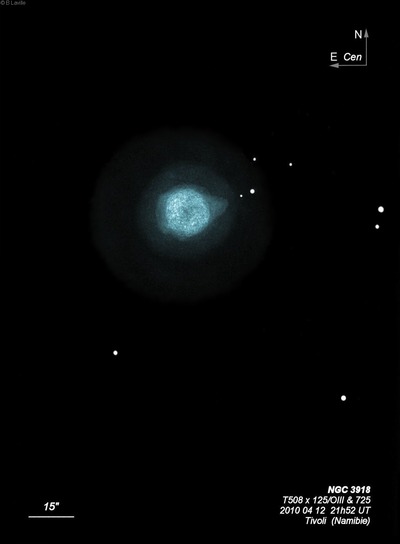
John Herschel discovered NGC 3918 = h3365 on 3 Apr 1834 and described this planetary as "perfectly round; very planetary; color fine blue;...very like Uranus, only about half as large again and blue." In a letter to Francis Baily from the Cape of Good Hope dated 22 Oct 1834, he added "On the 3d of April I discovered another fine planetary nebula, having a perfectly sharp disc, without the least haziness, of about 6" diameter. The most remarkable feature about this is its evident blue colour, which needs not the presence of lamp light, or that of any red star, to be very conspicuous, as it appears when the nebula stands alone in a dark field." On 5 Feb 1835 (sweep 543, the night described in his diary as "most superb" and "having attained the sublime of Astronomy - a sort of ne plus ultra") he wrote, he noted the color as "a beautiful rich blue, between prussian blue and verditter green...its outline is sharp and clean, and perhaps a very little elliptic. A feeble lamp light gives a deep indigo contrasted color."
James Dunlop first recorded this planetary in the Brisbane Star Catalogue of 1826 as a "fine blue star” (#3807) but did not note its non-stellar appearance.
Joseph Turner and Pietro Baracchi (1885) sketched the planetary with the Great Melbourne Telescope (unpublished plate V, figure 57).
The term "planetary", of course, had been used by William Herschel but he never made an analogy to Uranus. John Herschel wrote in his "A Treatise on Astronomy”, "They [planetary nebulae] have, as their name, exactly the appearance of planets." He also reported the colors of several as shades of blue (NGC 7009, 7662, 3242, 3918). See additional comments on M57.
300/350mm - 13.1" (2/20/04 - Costa Rica): at 195x, this 8th magnitude planetary appears as a beautiful 10"-12" blue disc with a very crisp edge. No central star was glimpsed or other structural details at this magnification though the surface brightness is unusually high. Situated in a rich star field but set near the middle of a oval 12'-13' ring of mag 11 and 12 stars which are near the periphery of the 17' field at 195x! Located 8.4' SSW of mag 8.1 HD 102817 and 19' SW of mag 5.6 HD 103101. The open cluster NGC 3960 lies 90' N.
400/500mm - 18" (7/10/05 - Magellan Observatory, Australia): at 76x appears as a bright, beautiful blue cosmic egg floating in a rich star field, ~15" diameter. The surface brightness is extremely high and uniformly lit, with a sharply defined edge to the disc. At 228x, the planetary appears to be set in the middle of an absorption hole in the Milky Way as there are very few faint stars in a 4' to 5' circular region surrounding the planetary. Outside this hole, the Milky Way background is very evident and fairly bright.
18" (7/8/02 - Magellan Observatory, Australia): at 171x, the "Blue Planetary" appears as a bright, round disc, ~15" diameter with a vivid blue color (V = 8.2). The surface brightness is very high and the edge of the halo is crisply defined, but no structural details or central star were noted. Good response to UHC filter, although it was unnecessary for a good view. The Milky Way is quite rich here in faint stars but the planetary seems to be set a darker, circular hole without the faint background glow - a contrast affect with the PN?
600/800mm - 24" (4/11/08 - Magellan Observatory, Australia): at 200x the "Blue Planetary" has an even, extremely high surface brightness disc of 15" and a saturated, vivid blue color. The edge is crisply defined and the disc has a uniform surface brightness. At 350x, the planetary is oval or irregular, perhaps 18"x15". There was no sign of the central star, though I didn't try high powers.
Notes by Steve Gottlieb
NGC 4945
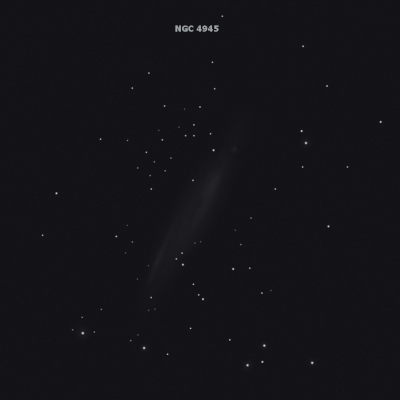
10x30mm Canon IS (3/28/19 - Tasmania): faint, large, very elongated glow. Required a careful look to see off and on, but easy to identify as situated just 18' E of mag 4.8 Xi 1 Centauri.
James Dunlop discovered NGC 4945 = D 411 = h3459 on 29 Apr 1826. This is one of the first objects observed by Dunlop (2nd night in logbook) and the first galaxy he discovered, along with NGC 5128 the same night. His description reads, "a beautiful long nebula, about 10' long, and 2' broad, forming an angle with the meridian, about 30 [degrees] south preceding and north following; the brightest and broadest part is rather nearer the south preceding extremity than the centre, and it gradually diminishes in breadth and brightness towards the extremeties, but the breadth is much better defined than the length. A small star near the north, and a smaller star near the south extremity, but neither of them is involved in the nebula. I have strong suspicions that the nebula is resolvable into stars, with very slight compression towards the centre. I have no doubt but it is resolvable. I can see the stars, they are merely points. This is north following the first zeta Centauri." Dunlop made a total of 7 observations and made a sketch (Figure 17).
John Herschel observed the galaxy on 31 Mar 1835 and recorded "B; vL; vmE; vglbM. Length much more than a diameter of the field, or than 15'. Its light extends to a star 14th mag beyond the parallel of Brisbane 4299. Position of elongation 38.7°." He placed the galaxy 10' too far north.
300/350mm - 12" (6/29/02 - Bargo, Australia): this long edge-on spiral is fairly bright and broadly concentrated with a slightly bulging core, extending SW-NE ~14'x2.5'. The surface brightness is relatively uniform with a weak central brightening and dimming towards the tips. Set in a rich star field peppered with faint stars. Located just north of a line connecting mag 4.8 Xi 1 Centauri 18' ESE and mag 4.3 Xi 2 31' SE. NGC 4976 is situated 30' E. Member of the Centaurus Group that includes both M83 and NGC 5128 and reddened by dust within our galaxy. NGC 4945 is comparable in dimensions to NGC 4565 although the dust lane was not evident.
600/800mm - 24" (4/11/08 - Magellan Observatory, Australia): remarkable spiral at 200x, extending southwest to northeast across 2/3 of the 30' field. I didn't take detailed notes on this observation but there was just a broad concentration with no well defined core region. The galaxy is very slightly wider through the center and only tapers towards the tips. Along the south edge, just southwest of center, is a brighter linear streak forming a sharp edge (the dust lane is just beyond). The main body of the galaxy fades a bit in this area and then brightens again further southwest. The major axis appears slightly warped or bent towards the north near the northeast tip, due to a large dust patch that bites a notch into the galaxy. On the south side of the northeast end, some very faint haze is visible. The DSS image reveals this is a portion of the galaxy beyond the dust lane. NGC 4945 is the second brightest member of the Centaurus A galaxy group and is situated 18' ENE of mag 4.8 Xi 1 Centauri.
Notes by Steve Gottlieb
NGC 5617
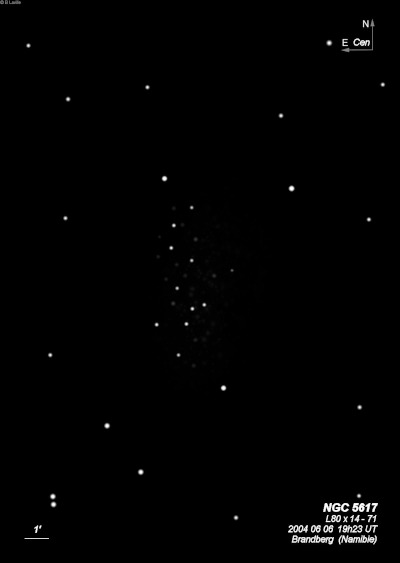
10x30mm Canon IS (3/27/19 - Tasmania): fairly faint, large, roundish, no obvious resolution. Alpha Centauri is in the field 1.2° ESE.
James Dunlop discovered NGC 5617 = D 302 = h3570 on 8 May 1826 with his homemade 9-inch speculum reflector and described "a cluster of small stars of mixt magnitudes, considerably congregated towards the center, 4' or 5' diameter." His position is just 2' southwest of the center of the cluster (well within the borders). John Herschel made 3 observations, first recording on sweep 578, "Cl VI. v rich; irreg R; pm comp M, but scattered at borders; 15' there are 3 stars 10m; 5 or 6 11m; the rest below 11m."
300/350mm - 13.1" (2/20/04 - Costa Rica): ~75 stars are irregularly distributed over a 10' region. The stars have a wide range of magnitudes from 10 to 14.5 and the cluster is dense in spots. Many of the stars are organized into strings with most arranged along a fairly rich string of stars running ~NNE-SSW. Additional groups of stars lies to the east and west. The cluster is easily located 1.2° WNW of Alpha Centauri between Alpha and Beta. The planetary He 2-111 lies 26' ESE.
Notes by Steve Gottlieb
NGC 5286
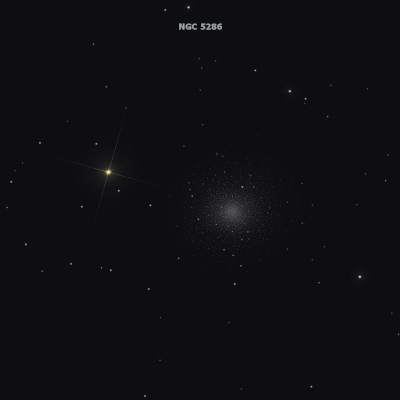
James Dunlop discovered NGC 5286 = D 388 = h3533 on 29 Apr 1826 with his 9-inch reflector and described "a bright exceedingly well-defined rather elliptical nebula, about 1' diameter, exceedingly condensed almost to the very edge, and gradually a little brighter to the centre. This is about 6' north of M Centauri - I have a strong suspicion that this is resolvable into stars." His position is 4.7' northeast of center. This one of the first few objects Dunlop discovered (same night as NGC 4945 and NGC 5128!)
John Herschel observed it on two sweeps, recording on 31 Mar 1835 "very bright; gradually much brighter to the middle; 2.5' or 3' diameter; resolved into 15th mag stars; has one star 12th mag S.f.; the centre near the edge. It is in the field with Brisbane 4618 a star of 6th mag." On his second sweep he reported, "bright; round; very gradually brighter to the middle; resolved; diam. 2'; stars of 16th mag; a bright star 7th mag in field."
200/250mm - 8" (7/13/91 - Southern Baja): moderately bright, fairly small, 2.5' diameter, round, evenly concentrated to a bright central region and a small bright core, mottled halo, one brighter mag 12 star on the SE side. On the verge of resolution although viewed at only 8° elevation. Mag 4.7 M Centauri with a mag 11 companion at 40" separation is located just 4.1' SE of the core!
300/350mm - 13.1" (2/20/04 - Costa Rica): at 105x this globular appeared very bright, moderately large and well-condensed with an intense, mottled core. At 200x, 15-25 14th magnitude stars popped in an out of view (some in chains), though only a handful were easily resolved, including a brighter star just east of the core. NGC 5286 is located 4' NW of yellow 4.7-magnitude M Centauri in the same high power field! It was easily visible in the 9x50 finder, though small. NGC 5307, a fairly bright planetary, lies 44' ENE.
Notes by Steve Gottlieb
NGC 3960
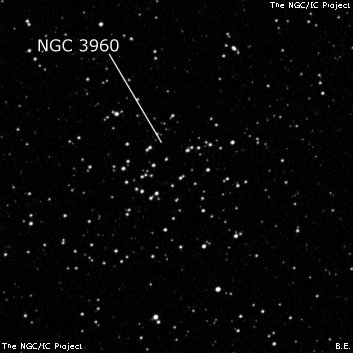
James Dunlop discovered NGC 3960 = D 349 = h3369 on 30 Apr 1826 and described "a pretty large, faint nebula, 6' or 7' diameter, easily resolvable with slight compression of the stars to the centre, or rather towards the following side of the centre." His position is just 5' south-southeast of center (relatively small error for him). JH only observed this cluster on one sweep (5 Apr 1837) and noted "cluster, VI class, pretty rich, irregular figure, round with long appendages, gradually pretty much brighter to the middle, 9', stars 13th magnitude."
300/350mm - 13.1" (2/20/04 - Costa Rica): roughly 30 fainter stars are resolved in a 6' group over unresolved background haze. The cluster is moderately bright, weakly compressed and rich in faint stars although it does not contain any stars brighter than 12th magnitude! Located 1.5 degrees due north of the "Blue Planetary", NGC 3918. NGC 3882 lies 56' SW. This is an old open cluster with an age of roughly one billion years.
Notes by Steve Gottlieb
NGC 5102
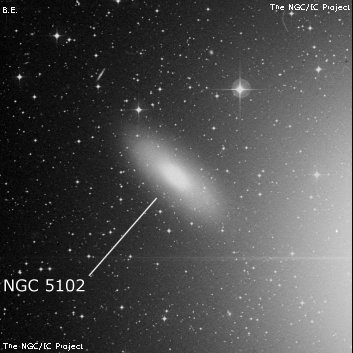
John Herschel discovered NGC 5102 = h3492 on 21 Apr 1835 and recorded "vB; R; svmbM; 50"."
200/250mm - 8" fairly faint, fairly large, elongated.
300/350mm - 13.1" (2/19/04 - Costa Rica): bright, fairly large, very elongated 3:1 SW-NE, 4.5'x1.5'. Sharply concentrated with a small, very bright core that increases to a sharp stellar nucleus. The extensions are much fainter and require averted vision to see their full extent. Located 17' ENE of Iota Centauri and 6.1' SE of mag 8.3 HD 116049. NGC 5102 is a luminous starburst S0 galaxy and a member of the Centaurus A group.
13.1" (3/17/86): fairly bright, small, very small bright core, elongated SW-NE. Located 17' ENE of Iota Centauri (V = 2.8) and 6.1' SE of mag 8 SAO 204385.
Notes by Steve Gottlieb
NGC 5307
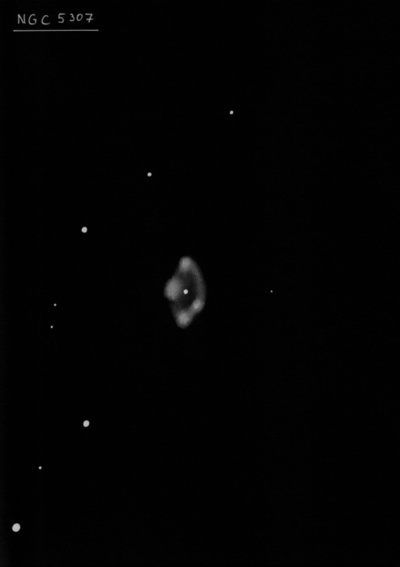
John Herschel discovered NGC 5307 = h3541 on 15 Apr 1836 and recorded "A very singular object. At first I thought it an ill seen double star; 12..13 = 12..13 mag; distance 2"; but not being able to get it into focus I applied 320 power; which showed it as a hazy, rather elongated, planetary nebulous disc, as if a double star all but obliterated. It is positively not a star. The field is full of stars, two of which are equal to this object in light, but 320 shows them both quite sharp. It is a difficult object to find, and unless in a good night for definition (this is superb) it could not be recovered. The place is well taken. It is the smallest and most difficult planetary nebula I have ever seen. Figure 15, plate VI, exhibits its appearance with power 320 (N.B. By this figure it would seem rather to belong to the class of double nebulae or double stellar nebulae of the utmost remoteness, than to that of planetary nebulae, properly so called.)"
Joseph Turner observed and sketched the planetary on 23 Jul 1875 with the Great Melbourne Telescope (unpublished Plate VII, figure 70). He noted a "bluish tinge" and commented that Herschel's sketch showed it as a double nebula (two condensations), but he couldn't see a duplex character, although it was elongated N-S (Herschel sketched it NW-SE).
200/250mm - 10" (6/29/02 - Bargo, Australia): at 214x and UHC filter, this small, fairly bright planetary appeared as a slightly elongated disc, ~13"x10" in diameter with a high, fairly even surface brightness except for a weak brightening at the center, but no definite central star. Set in a rich star field 45' ENE of globular NGC 5286 and mag 4.7 M Centauri.
400/500mm - 18" (7/5/05 - Magellan Observatory, Australia): fairly bright, small, blue-green oval, ~15"x10". This unusual planetary has an irregular, wispy surface brightness with fascinating glimpses of structure at 293x and 428x. It appears brighter along the major axis, particularly at the south end with a couple of small, darker areas or regions where the nebulosity is weaker on the sides. A trio of mag 13-14 stars to the southeast is collinear with the planetary. Situated in a fairly rich star field.
Notes by Steve Gottlieb
NGC 3699
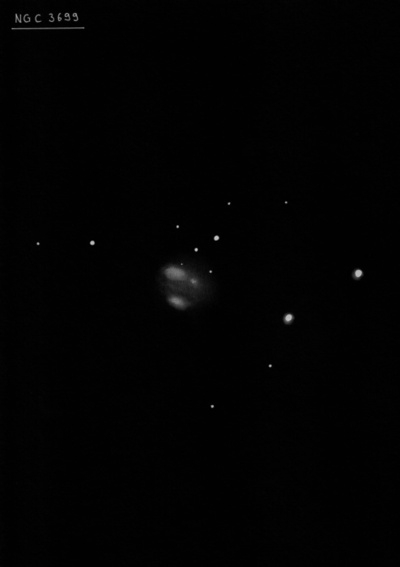
John Herschel discovered NGC 3699 = h3345 on 1 Apr 1834 and recorded "B; pL; irr R; pgpmbM; 90"; r. Almost resolved. It is, however, by no means a mere knot of the Milky Way." Joseph Turner sketched this planetary on 8 Apr 1878 with the 48" Melbourne Telescope. It accurately showed two segments cut by a "dark channel on the following side". The dark lane is oriented NE-SW with the cut off section to the east much smaller and the dark lane slightly wider at the NE end. Robert Innes observed it with the 9-inch refractor at the Union Observatory in Johannesburg in 1914 and called it "a faint nearly round nebula 60" in diameter, mag = 14th."
300/350mm - 13.1" (2/17/04 - Costa Rica): at 100x, this planetary appeared moderately bright and large, ~60"-65" in size. There was a good contrast gain with a UHC filter at 105x and 166x and it appeared brightest on the north side of the planetary. A dark rift running WSW-ENE appears to nearly detach the smaller and fainter southern section.
400/500mm - 18" (7/7/02 - Magellan Observatory, Australia): at 128x this interesting planetary is moderately bright, fairly large, ~70" in diameter with some faint stars superimposed. With the UHC filter the appearance is very unusual with a dark rift bisecting it in a WSW-ENE orientation just below the geometric center. At 228x, the northern "hemisphere" is both larger and brighter with an irregular surface brightness. A mag 13 star is ~1' NW. This is a fascinating planetary set in a beautiful Centaurus star field with an appearance similar to faint HII region or a small version of Cen A!
600/800mm - 24" (4/5/08 - Magellan Observatory, Australia): this showpiece planetary appeared very bright, fairly large, ~70" in diameter. It displayed an excellent contrast response using an UHC filter at 200x. The planetary is bisected by a prominent, broad dark rift that slashes through the planetary from WSW to ENE (like Centaurus A!). The northern lobe is the more prominent: both larger and brighter. The shape of this lobe is semicircular with a round, outer periphery but with a fairly straight edge SW-NE in the interior due to the dark rift. The center of the dust lane is south of the geometric center of the planetary, giving an asymmetric distribution to the lobes. The rift itself is widest at the ENE end and tapers down towards the WSW end. Superb view at 350x as the extra magnification increases the contrast and confirms that the south lobe is fully detached by the dust lane at the WSW end. The compact planetary He 2-67 lies in the same field 11' SE.
Notes by Steve Gottlieb
IC 2944
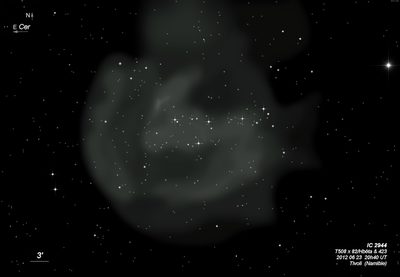
10x30mm Canon IS (3/28/19 - Tasmania): prominent region in 10x30 binoculars. Includes Lambda Centauri and 4 bright stars in a string to the southeast. These stars are involved in an extremely large nebulous haze (unfiltered).
Royal H. Frost discovered IC 2944 = F. 789, along with IC 2948, on a 24-inch photographic plate taken at the Arequipa station on 5 May 1904. He noted nebulosity but not the scattered cluster. Images reveal several interesting dark blobs called Thackeray's Globules (dense star forming regions). The IC designations refer to different parts of the same HII complex. See Harold Corwin's notes on this object.
300/350mm - 13.1" (2/18/04 - Costa Rica): this is a bright and fascinating HII region southeast of Lambda Centauri using an OIII filter and 20mm Nagler combination! Surrounds open cluster Cr 249, which is encased in nebulosity. Additional haze extends beyond the cluster towards the southeast for several arcminutes. At this point there is a sharp bend and a bright section of nebulosity extends to the north. This section is wider and brighter than other regions. The brightest sections roughly form a huge "7" shape, perhaps 30' in size! This object is referred to as the "Running Chicken Nebula" and photographs reveal several embedded Bok globules.
Notes by Steve Gottlieb
NGC 5662
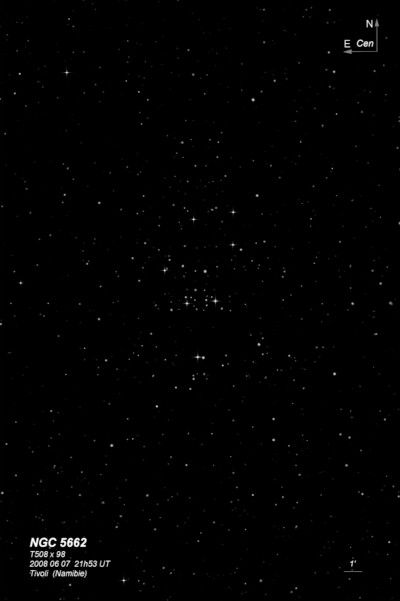
Nicolas-Louis de Lacaille discovered NGC 5662 = Lac III-8 = D 342 = h3573 in 1751-1752 with a 1/2" telescope at 8x during his expedition to the Cape of Good Hope. It was included in his 1755 catalogue as Class III No. 8. and noted as "two stars in nebulosity."
James Dunlop observed the cluster on 25 May 1826 and recorded "A group of small stars of the 11th and 12th mag, with a multitude of minute stars mixt, extended S.p. and N.f." His position was off by 9'. JH observed the cluster twice from the Cape. On 23 Apr 1835 he noted "large, p brilliant, coarse, sc cl of Class VII which more than fills the field; 50 stars more or less 9..12th mag; chief star 7th mag, somewhat insulated, taken for place of cluster." On a later sweep he logged "place of a red star, the chief and centre of a fine bright, but not rich cluster, of about 30 stars 9..13 mag. This red or high yellow star is 8th mag."
400/500mm - 18" (7/5/05 - Magellan Observatory, Australia): this cluster stands out well with the 27mm Panoptic (76x) with ~60 stars resolved in a 12'x9' region. The stars around the periphery are arranged in a distinctive concave pentagon similar to a court jester's crown. Includes three mag 9 stars as well as a number of mag 10.5-11 stars. The richest group of stars is on the SW side and includes a mag 9 luminary along with over a dozen stars within 3' including 5 or 6 of mag 10.5/11. The cluster is too large for a pleasing view at 228x. Situated a few arc minutes following orange-colored mag 7 HD 127753, which is isolated from the main group, though was given as the position of the cluster by John Herschel.
Notes by Steve Gottlieb
NGC 5281
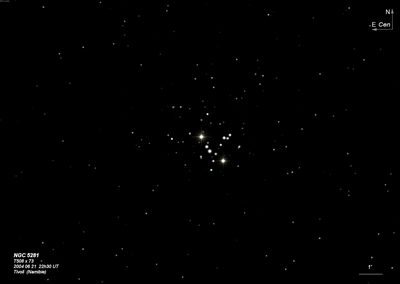
Nicolas-Louis de Lacaille discovered NGC 5281 = Lac I-7 = D 273 = h3531 in 1751-1752 during his expedition to the Cape of Good Hope. With a 1/2" telescope at 8x he noted a "small indistinct spot." James Dunlop described D 273 as "a curved line of small stars, about 1.5' long, with a star of the 7th mag in the north extremity; a group of extremely minute stars on the preceding side of the crescent, and a multitude of very minute stars extended preceding and following." Dunlop sketched the cluster (Fig. 11) and observed it 7 times. John Herschel called it (sweep 596) "a brilliant, compact, milky way cluster. Rich; irreg fig; gbM; 10' stars 10, 11 and 12m."
300/350mm - 14" (4/4/16 - Coonabarabran, 178x): very bright, striking cluster including a 2' string containing (from southwest to northeast) four stars mag 8.4, 7.9, 8.5 and 6.6 (at the northeast end). A 2' linear chain of 7 mag 10-11 stars intersects these bright stars. The central 4'-5' region contains ~50 stars, but many stars are scattered outside this region, extending the size of roughly 10'. NGC 5269 (probably an asterism) lies 12.5' W.
400/500mm - 18" (7/6/05 - Magellan Observatory, Australia): this large, rich cluster is striking at 128x. A curving 2' string of four stars mag 6.6-8.6 oriented SW-NE dominate the view, with a pale yellow star and an orange star at opposite ends adding color. Overall, perhaps 150 stars are visible (many mag 11-12) in an irregular 10' region although the boundaries are arbitrary as the cluster blends into the surrounding fields. Most of the brighter stars are within a 3' region and in fact the catalogued diameter is only 5'. At 228x, another fainter layer of 15th magnitude stars emerged from the background.
Notes by Steve Gottlieb
NGC 5316
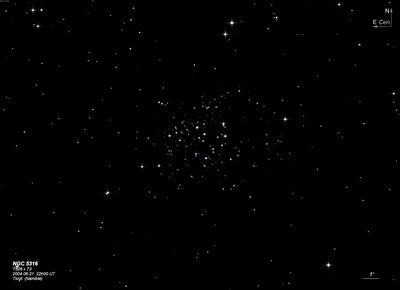
10x30mm Canon IS (3/27/19 - Tasmania): fairly faint, moderately large cluster in binoculars, irregular shape, no obvious resolution.
James Dunlop discovered NGC 5316 = D 282 = h3542 on 25 May 1826 and described "A group of ten or twelve stars about the 10th mag, with a multitude of very small stars, forming an irregular branched figure, 8' or 10' long and 6' broad." His position is only off by 3'. JH observed the cluster on 24 Apr 1835 and noted it as a "cluster of stars, class VII; 14 stars 11th mag, and 30 or 40 smaller in a round space 8' diameter." He credited Dunlop, due to his relatively accurate position.
300/350mm - 13.1" (2/19/04 - Costa Rica): this fairly bright open cluster consists of 35-40 stars in a 10' triangular group. Includes a number of brighter mag 9.5-12 stars. Off the NE side is a neat string of stars oriented WNW-ESE.
400/500mm - 18" (7/5/05 - Magellan Observatory, Australia): at 171x (12mm Nagler), over three dozen stars are visible in a 10'x6' bright triangular group. A number of mag 10 and 11 stars define the periphery and make the cluster appear well-detached although a number of additional mag 9 and 10 adorn a glittering field. Extending off the north side and heading NW is a 6' string of 11th-12th magnitude stars ending at a mag 10.8 star 7' NW of the center of the cluster. The chain then abruptly changes direction and continues SW, terminating at mag 8.5 HD 120631 located 10' W of the center of the cluster. The two intersecting strings are distinctive but appear to be random asterisms.
Notes by Steve Gottlieb
NGC 5138
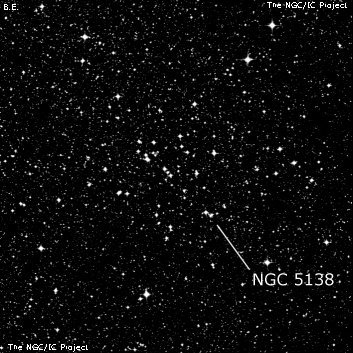
James Dunlop discovered NGC 5138 = D 312 = h3503 on 26 May 1826 with his 9-inch f/12 reflector at Parramatta. He recorded "a pretty large faint nebula, about 5' diameter, irregular branched figure, resolvable, with considerably compression of the stars towards the central point. This precedes a star of the 7th mag, and a group of small stars follows, about 10' north of the nebula." His catalogued position was 14' too far south but Glen Cozens found a transcription error of 20' from his handwritten position, with his original position 6' too far north.
John Herschel tentatively identified his h3503 as Dunlop 312. He observed the cluster twice; on 3 May 1835 he recorded "General middle of cluster VIII. class. pB; L; irr; scattered, 30 or 40 stars 11..12 mag and many smaller; pretty well insulated, though on a ground rich in very small stars." On a second sweep he logged "Cluster VII class; rather a fine cluster; rich, but loose and straggling. Fills field. Stars 11 and 12th mag."
400/500mm - 18" (7/11/05 - Magellan Observatory, Australia): at 228x, roughly 100 stars are visible in a 12' region, though the group is not detached well enough at this power to recognize as a cluster. At 76x (27 Panoptic), barely stands out as a distinct group as it resides in a very rich star field. Includes over two dozen mag stars roughly 11th magnitude. Two mag 8.5/9.5 stars (HD 116721 and 116689) to the NW by 6' and 9' are collinear with the center of the cluster.
Notes by Steve Gottlieb
NGC 3680
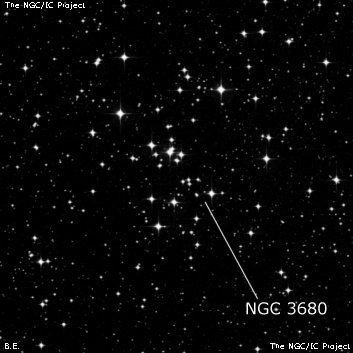
James Dunlop discovered NGC 3680 = D 481 on 7 May 1826 and recorded "a cluster of stars, about 10' diameter, mixt magnitude. This precedes 25 Centauri." Dunlop made 4 observations of this cluster and his position is roughly 10' SE of the center of the large cluster (typical error). On John Herschel's first sweep (h3342) of 3 Feb 1835 he logged "cluster VIII class, 60 or 70 stars 11..13th mag in a compact round space, 10' diameter." His second observation reads: "not very rich but a good cluster; gradually compressed in the middle, large, rich, very scattered, almost fills field, stars 10..14th mag."
300/350mm - 13.1" (2/18/04 - Costa Rica): scattered group of a dozen stars at 105x in 7' but with an interesting arrangement as many of the stars form two intersecting lanes crossing at a right angle. Includes a few mag 10-10.5 stars.
Notes by Steve Gottlieb
NGC 5606
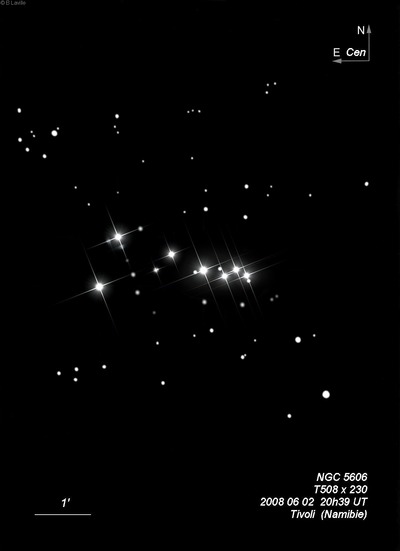
James Dunlop discovered NGC 5606 = D 313 = h3568 on 8 May 1826 and recorded "a very minute group of small stars, about 2' long, extended in the parallel of the equator." JH made a single observation on 6 July 1836: "a small close group of large and small stars, forming a cluster."
400/500mm - 18" (7/5/05 - Magellan Observatory, Australia): at 228x, this is a compact, distinctive group of two dozen stars mag 8.7-15 including four mag 8.7-10 stars in a 2'-3' region. Two of these stars form a wide 21" pair on the west side and are surrounded by several faint companions creating a rich clump. The main group is only 2.5' in diameter, though it is situated in a glittering, rich star field so the cluster is not completely detached from the surrounding field.
Notes by Steve Gottlieb
NGC 4852
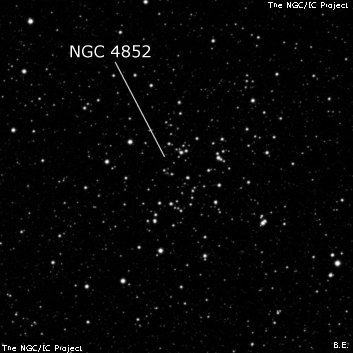
James Dunlop discovered NGC 4852 = D 311 = h3449 on 30 Apr 1826 with his 9-inch reflector from Parramatta, New South Wales, and recorded "a very faint pretty large nebula about 6' or 8' diameter, round figure, resolvable into very minute stars. Several stars of some considerable magnitude appear scattered among the minute stars of the nebula, but they are only the continuation of a branch of small stars which run over the place where the nebula is; the stars in the nebula are very gradually, but not much, compressed to the centre." He observed the cluster of 4 times and his catalogued position is ~8' SE of the center of the cluster.
On 31 Mar 1834, JH recorded "a very poor cluster of about 70 stars 11..15th magnitude, very loosely scattered over a space about 15' long and 8' br." His second observation reads "Cluster VII. p rich, L, irr R, 10' diameter, 80 or 100 stars, 10, 11, 12 mag, with a stippling of much smaller ones."
600/800mm - 24" (4/12/08 - Magellan Observatory, Australia): I'm surprised I didn't look for this cluster previously from Australia or Costa Rica as it is located just 1.1° NE of the Jewel Box and 1.6° east of mag 1.3 Beta Crucis! At 200x it was a pretty impressive collection of ~150 stars mag 10-16 in a 10' region including several mag 10-10.5 stars. One subgroup makes a neat "zig-zag" or "M" outline while another set of stars forms a "V" shaped group. There are no real rich subgroups but still it forms a nice cluster.
Notes by Steve Gottlieb
NGC 5168
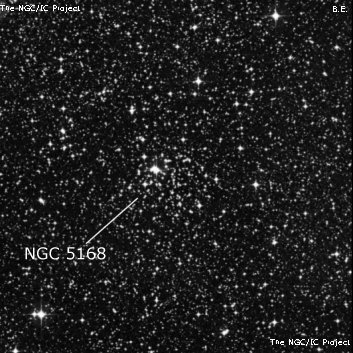
John Herschel discovered NGC 5168 = h3512 on 16 Jun 1835 and recorded "A small but very rich milky way cluster; 3.5' l, 3' br; st 13...16m. Place that of a double star [HJ 4591]." On a later sweep he added "place of a double star in centre of a rich, much comp but vF cluster; gbM; 4' diam; st 15m; a remarkable object."
400/500mm - 18" (7/11/05 - Magellan Observatory, Australia): gorgeous low power Milky Way field at 76x, but it was difficult to identify the cluster not having a finder chart. Initially I was drawn to a striking asterism in the field consisting of a distinctive group of four stars forming a rough 8'x3' parallelogram with brightest member mag 7.8 HD 117356, but the enclosed stars were no richer than the surrounding field and it looked like an asterism. Then I noticed that 12' S of the mag 7.8 star was an eye-catching double star = HJ 4591 (10.2/10.4) at 7" surrounded by a few faint stars over unresolved haze. Increasing the magnification to 228x, this rich knot resolved into three dozen mag 14 and fainter stars in a 2'x1.5' roundish cluster with the double star on the following side and this was clearly NGC 5138.
Notes by Steve Gottlieb
NGC 4230
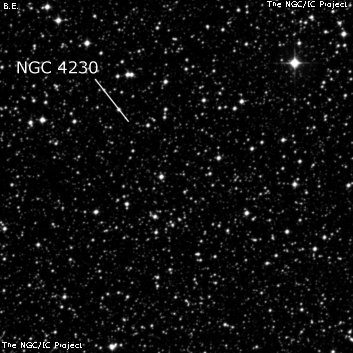
Note the group of stars described here is 12' S of ESO 171-SC14, the cluster identified as NGC 4230 in most sources including SIMBAD and ESO. ESO 171-SC14 is a cluster of roughly two dozen mag 13-14 stars in a 3' region just southeast of mag 8.4 HD 106826. A couple of mag 11 stars are 2' E and 3.5' NE of the mag 8.4 star, but these are detached.
John Herschel discovered NGC 4230 = h3386 on 5 Apr 1837 and described a "Cluster class VI. F; pL; irreg; 6'; resolved into stars 13, 14, 15m. Place of a * 12m, chief and near the middle of cluster." At his position is an unimpressive 5' group of star that is likely an asterism, with the brightest star 12th magnitude. This is the "cluster" identified by Harold Corwin as NGC 4230. Corwin notes that ESO (and SIMBAD) misidentify ESO 171-SC14 as NGC 4230. This group of stars is scattered southeast of a mag 8 star -- too bright not to have been mentioned by JH. See Harold Corwin's identification notes for more on this number.
300/350mm - 14" (4/4/16 - Coonabarabran, 73x and 178x): roughly 40 stars are resolved in a 7'x5' region (the outline is pretty arbitrary), roughly elongated SW-NE. Appears as an unimpressive asterism with no rich subgroups. A mag 11.5/13 pair at 13" separation is southwest of center with several mag 13-14.5 stars to its northeast. A mag 12 star 2' SW and a mag 11 star 4' SW of the central pair are all collinear. Located 18' SW of mag 5 Delta Crucis.
Notes by Steve Gottlieb
IC 4291
Robert Innes discovered IC 4291 visually in 1901 using the 7-inch Merz refractor at the Royal Observatory, Cape of Good Hope. He remarked, "this is a small round nebula about 1' in diameter, brighter towards the centre." Harold Corwin notes that although Innes' description seems to refer to a small nebula or galaxy, this is a open cluster spanning 4' or 5', with a brighter core of 2'.
Paris Pismis reported it as new in her 1959 list of 24 new clusters found with the Schmidt camera at the Tonantzila observatory and noted Pismis 18 as "Six stars brighter than 10.5m to 12m; the brightness of the members gradually declines."
400/500mm - 18" (4/1/19 - OzSky): at 182x; very elongated cluster in a triangular, wedge-shaped outline with the brightest mag 10.8 star at the NE tip. There are 5 additional stars close by to the south. Another small group of stars forms the west vertex, with these stars detached from the first group by a noticeable gap or hole in the cluster. A few additional stars form the eastern side of the triangle. Perhaps 20-25 stars in total were resolved.
Notes by Steve Gottlieb
NGC 5161
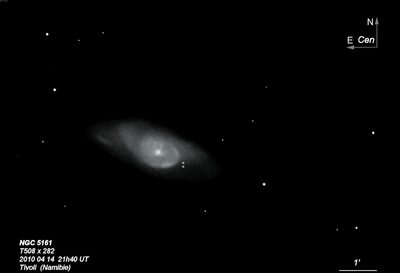
John Herschel discovered NGC 5161 = h3511 on 3 Jun 1836 and recorded "pF; L; pmE; vgbM; r; 4' l; 2' br; with left eye feebly stippled." His position is accurate.
400/500mm - 18" (5/29/05): large, oval WSW-ENE, ~4'x2'. Broad concentration with a large, ill-defined core that seems offset to the east side (or the outer halo is irregular lit). A mag 10.3 star lies 3.9' W of center and a mag 11.5 star is off the NE flank. This photogenic spiral (thin arms with knots and HII regions) was host to a pair of recent supernovae – 1998E and 1974B.
Notes by Steve Gottlieb
NGC 5408
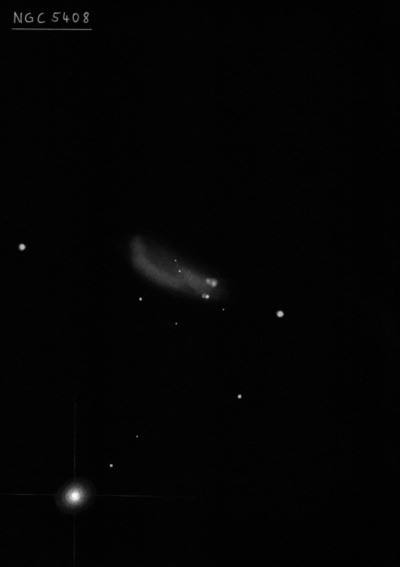
This nearby dwarf irregular starburst galaxy lies 15.6 million light years distant in the M83/Centaurus A group. It was misclassified as a planetary nebula in the first edition of the Sky Catalogue 2000 and NGC 2000. Henize 3-959 = StWr 4-9 likely refers to the small clump of HII regions on the southwest side of the galaxy.
John Herschel discovered NGC 5408 = h3553 on 5 Jun 1834 and recorded "eF; E between 2 vS stars, a little sf." His position (single observation) is 2' south of the emission-line galaxy ESO 325-047. This galaxy was misclassified as a planetary in the Sky Catalogue 2000 and the NGC 2000 because it was found by Stock and Wroblewski in 1972 (SKWL 4-9) and listed as a PN in a PK update list (PK 317+19.1) with the comment "extragalactic HII region?". In 1972, Allen reported this object as a peculiar galaxy with a redshift of 500km/s. MCG does not label -07-29-006 as NGC 5408.
400/500mm - 22" (6/28/06 - Hawaii): at 200x; NGC 5408 appeared fairly faint, small, elongated ~2:1 SW-NE, 0.8'x0.4'. A faint star is at the southwest end. Located just 3' NNW of mag 6.1 HD 122532 and the galaxy is bracketed by a mag 10 star 1.5' SW and a mag 11 star 2' E. The "faint star" noted on the southwest end may be an ultra-luminous star formation region (see below).
Notes by Steve Gottlieb
NGC 5124
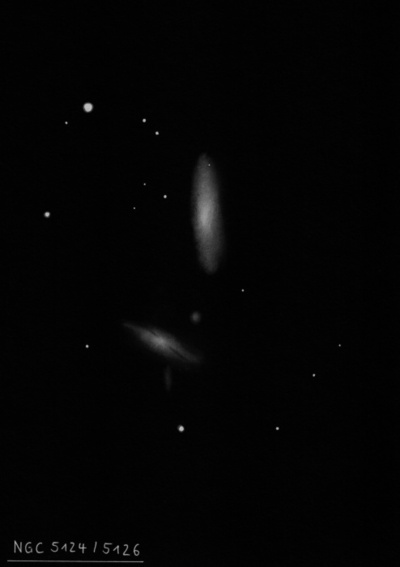
400/500mm - 18" (6/4/05): fairly faint, fairly small, elongated ~5:2 N-S, 1.2'x0.5', fades at the tips. Fairly well concentrated with a small, brighter round core ~15" diameter and fainter extensions. Three mag 8.5-10 stars to the SE with mag 8.4 HD 116623 6.4' SE. Forms a close pair with NGC 5126 1.6' SSE.
Notes by Steve Gottlieb
NGC 4672
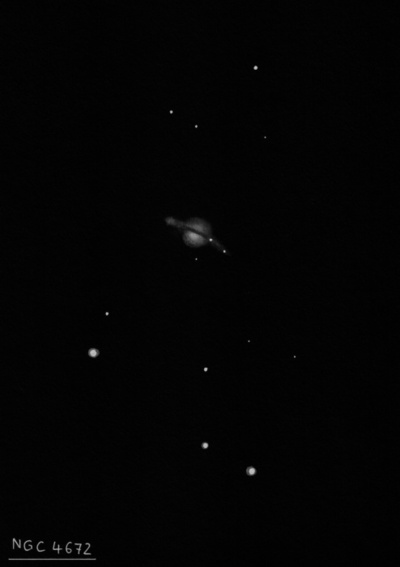
John Herschel discovered NGC 4672 = h3416 on 8 Jun 1834 and recorded "eF; S; R; vgbM." He later added the noted "Right reduced. See No. 3413." His position matches ESO 322-073 = PGC 43073, a polar ring galaxy.
300/350mm - 14" (4/2/16 - Coonabarabran, 160x): fairly faint, fairly small, elongated 2:1 SW-NE, slightly brighter along the major axis, broad weak concentration. A group of five stars is south and southwest including a mag 11.8 star 3.5' S and a mag 12.3 star 2.4' SE. NGC 4672 is a member of the Centaurus Cluster (AGC 3526) with NGC 4677 11' NE, NGC 4645 24' WSW and NGC 4696D 24' E.
Notes by Steve Gottlieb
NGC 5367
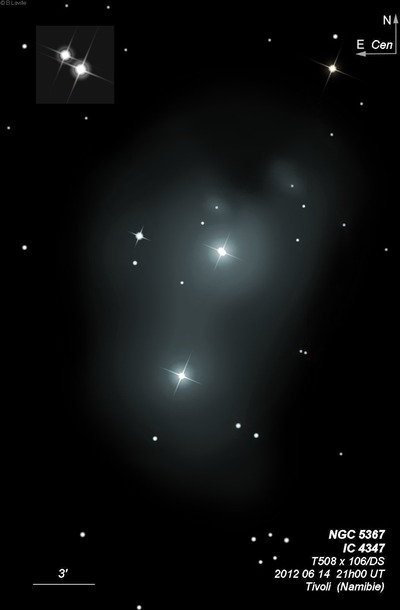
400/500mm - 17.5" (5/4/02): this unusual reflection nebula surrounds a bright, close pair of mag 10.3/10.7 stars at 4" (h4636). The nebula appeared as a round, fairly faint, 3' glow surrounding the illuminating stars. Although the elevation was only 10° at the time of the observation, the hazy glow was pretty evident. A brighter mag 9 star lies 4' ENE.
Notes by Steve Gottlieb
PK 290+7.1
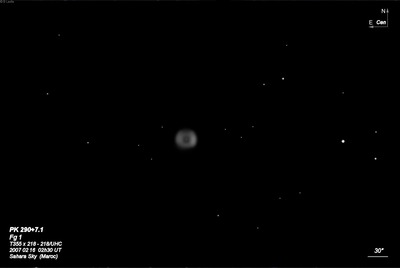
| Type | PN [3(4)] |
| RA | 11:28:36.2 |
| Dec | -52:56:04.0 |
| major_axis | 60.0'' |
| mag | 11.4 |
| surface_bright | 9.6 |
Lo 5
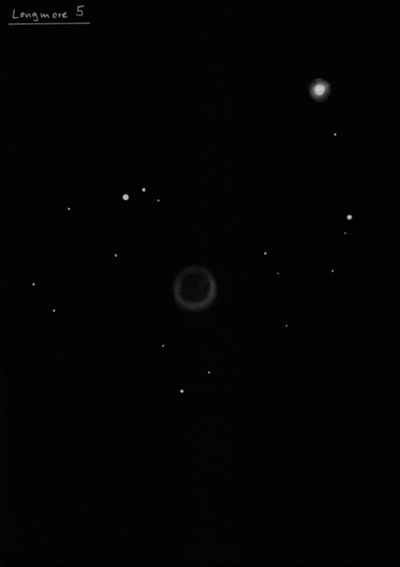
| Type | PN |
| RA | 11:13:54.1 |
| Dec | -47:57:01.0 |
| major_axis | 3.6' |
| mag | 11.7 |
| surface_bright | 14.2 |
ESO 217-11
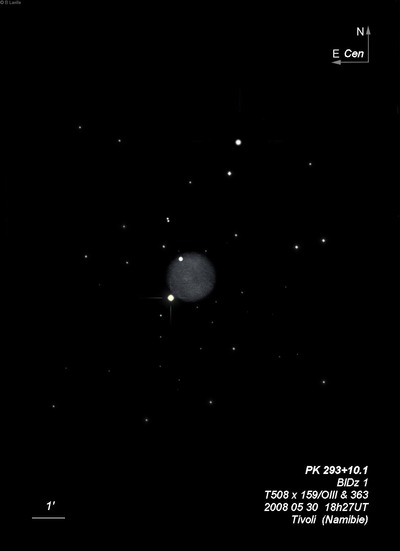
| Type | PN |
| RA | 11:53:06.6 |
| Dec | -50:50:59.0 |
| major_axis | 84.0'' |
| mag | 12.3 |
| surface_bright | 12.7 |
K 1-23
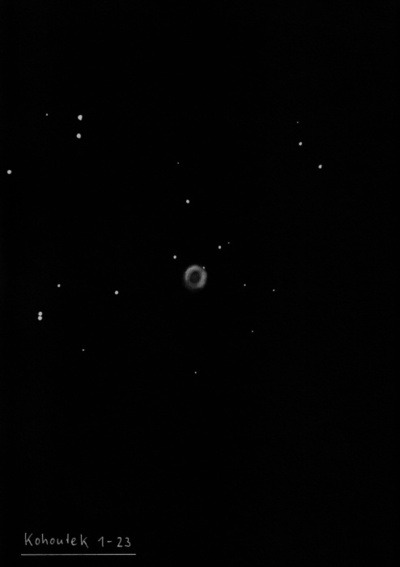
| Type | PN |
| RA | 12:30:52.6 |
| Dec | -44:14:16.0 |
| major_axis | 42.0'' |
| mag | 12.6 |
| surface_bright | 11.6 |
HCG 63
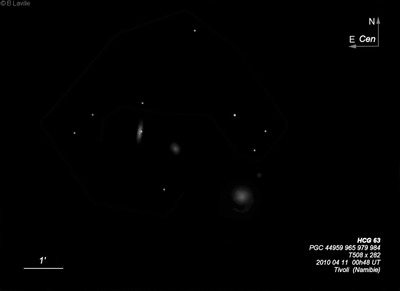
| Type | GALCL [S3] |
| RA | 13:02:10.0 |
| Dec | -32:46:05.0 |
| major_axis | 3.8' |
| mag | 13.1 |
| surface_bright | 99.9 |
NGC 4650A
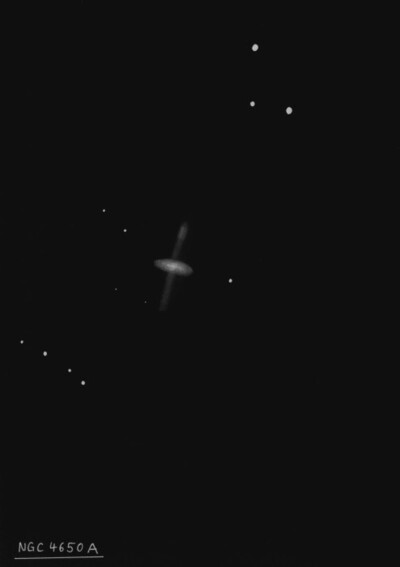
| Type | GX [S0-a] |
| RA | 12:44:49.0 |
| Dec | -40:42:52.0 |
| major_axis | 96.0'' |
| minor_axis | 48.0'' |
| position_angle | 158.0 |
| mag | 13.3 |
| surface_bright | 13.3 |
PGC 49877
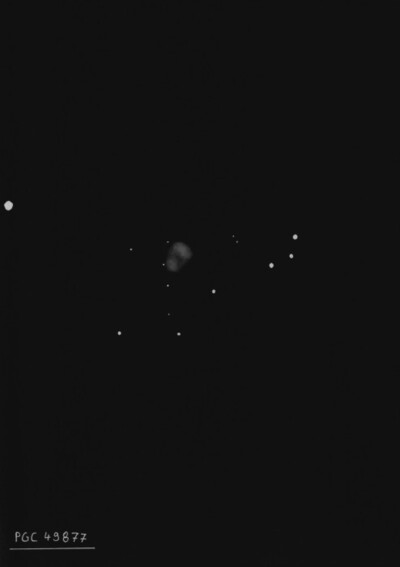
| Type | GX |
| RA | 14:00:42.6 |
| Dec | -51:02:24.0 |
| major_axis | 2.29' |
| minor_axis | 90.0'' |
| mag | 14.5 |
Lo 6
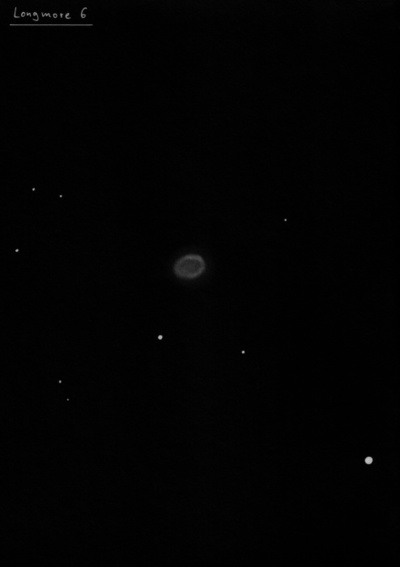
| Type | PN |
| RA | 12:00:43.5 |
| Dec | -47:33:12.0 |
| major_axis | 60.0'' |
| mag | 15.3 |
| surface_bright | 15.1 |
IRAS 12419-5414
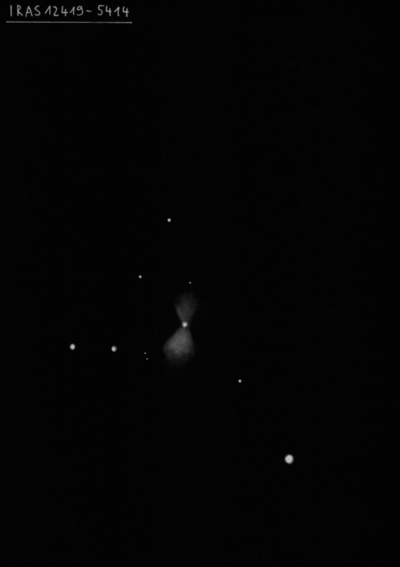
| Type | PN |
| RA | 12:44:46.1 |
| Dec | -54:31:13.0 |
| major_axis | 78.0'' |